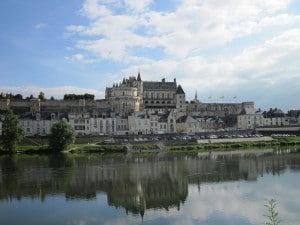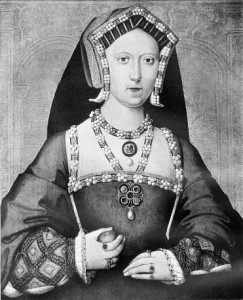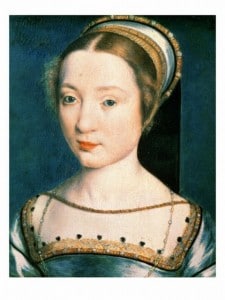
In the fifth article of my “Anne Boleyn’s Life” series, I’m going to look at Anne’s time in France…
Anne Boleyn had left her home of Hever Castle in Kent to travel to Margaret of Austria’s court in Mechelen (in present day Belgium) in the summer of 1513. It is not known how long her father had arranged for her to remain with Margaret, but on 14 August 1514 Thomas Boleyn wrote to his Margaret asking her to release Anne and send her back to England with a chaperone sent by him. Anne had been chosen to accompany Mary Tudor, Henry VIII’s 18 year-old sister, on her journey to France to marry King Louis XII. As Thomas explained to Margaret, it was a request that “I could not, nor did I know how to refuse.”1 He needed Anne back.
As I explained in an earlier article on this subject, it is not clear when Anne Boleyn arrived in France. The late historian Eric Ives wrote of how the list of ladies paid for the period October to December 1514 shows the name “Marie Boulonne”, but not Anne, so it may be that her sister Mary attended Mary Tudor on her crossing to France, for the wedding which took place on the 9 October 1514 at Abbeville, and that Anne caught up with the royal party in Paris when Mary was crowned queen on the 9 November. Ives hypothesises that Margaret of Austria may not have got Thomas Boleyn’s letter in time to send Anne home to England, because she was visiting the islands of Zeeland at the time, so she organised for Anne to travel directly to France.2
On 10 October 1514, the day after his marriage to Mary Tudor, Louis XII dismissed a large number of Mary’s attendants, believing that his queen should be served by French servants. A “Madamoyselle Boleyne” appears in the list of “Names of the gentlemen and ladies retained by the King (Louis XII)”, but, again, it is unclear whether this was Anne or Mary.3 Perhaps Mary Boleyn returned to England and it was Anne who was retained, or perhaps this “Madamoyselle” was Mary and Anne hadn’t arrived in France yet.

On 1 January 1515, less than three months after the wedding, 52 year-old Louis XII died. Louis’ successor was Francis, Count of Angoulême, the only son of the late Charles, Count of Angoulême, and Louise of Savoy. Francis was not only Louis’ cousin’s son, he was also Louis’ son-in-law because he had married Louis’ eldest daughter, Claude, in 1514. Francis was crowned Francis I of France on 25 January 1515. Henry VIII sent his good friend Charles Brandon, Duke of Suffolk, to France to bring his sister back to England. Mary had fallen in love with Suffolk before her marriage to Louis and so took the opportunity to marry him in secret in March 1515 before returning to England. Although this was an act of treason and Henry VIII was furious, he eventually forgave the couple and they were officially married on the 13th May 1515 at Greenwich Palace, having been fined for their disobedience.
For some reason, Anne Boleyn did not accompany her mistress back to England in 1515 and, instead, stayed on in France and joined the household of 15 year-old Queen Claude. Anne Boleyn’s name is missing from the household lists of Queen Claude, but we know that Anne served Claude between 1515 and 1521 because of the following evidence:
- Francis I reported on 22nd January 1522 that “Mr. Boullan”‘s daughter had been recalled from the French court:
“I think it very strange that this treaty of Bruges was concealed from me, and also the powder and balls which are going to Antwerp;—that his subjects go and take the Emperor’s pay;—that the English scholars at Paris have returned home, and also the daughter of Mr. Boullan, while ships were being made at Dover, and musters taken in England, the rumor being that it was to make war on France.”4
Mary Boleyn was in England at this time, having married William Carey in February 1520, so the French king must have been referring to Anne Boleyn. - The imperial ambassadors reported to Charles V, Holy Roman Emperor, in January 1522 that “Boleyn’s daughter, who was in the service of the French queen, had been called home” and that “The cardinal said that he himself was responsible for her recall, because he intended, by her marriage, to pacify certain quarrels and litigation between Boleyn and other English nobles.”5 Although Francis I was worried that Anne had been recalled to England because England was planning war on France, the imperial ambassadors share the news that Cardinal Wolsey had made it clear that Anne’s return to England was due to marriage plans he had for her. The Boleyns and St Legers (Thomas Boleyn’s aunt’s family) were, at this time, arguing with Piers Butler over the title Earl of Ormond, following the death of Thomas Boleyn’s grandfather, Thomas Butler, 7th Earl of Ormond. Cardinal Wolsey was attempting to broker a marriage between Piers’s son, James, and Anne Boleyn to put an end to the dispute.
- Queen Claude’s sister, Renée of France, Duchess of Ferrara, told Nicholas Throckmorton in Elizabeth I’s reign: “There was another cause which worked in her a goodwill towards the Queen [Elizabeth I]; there was an old acquaintance between the Queen’s mother [Anne Boleyn] and her, when the former was one of the maids-of-honour of the Duchess’s sister, Queen Claude.”6
- Lancelot de Carles, secretary to the French ambassador in England in 1536, wrote a poem about Anne Boleyn’s life and in it he wrote that Anne first went to France when Mary Tudor left England to marry Louis XII and that Anne was then retained by Mary’s successor, Claude.7
- William Camden, the 16th century chronicler writing during Elizabeth I’s reign, wrote that Anne had served Queen Claude and Marguerite of Angoulême. Historian Baron Hebert of Cherbury (1583-1648) recorded that Anne was “said by the French writers to have lived in that court”, i.e. the French court.8

The French Court
Anne Boleyn had already spent over a year on the continent when she joined Queen Claude’s household and had learned French and been exposed to a Renaissance court led by a woman who was a patron of the Arts – see Anne Boleyn’s Education and her time at Margaret of Austria’s Court for more details. Anne would have continued to perfect her language and singing and dancing skills at the French court, while also enjoying the sophisticated atmosphere and French fashion.
Like Margaret of Austria, Queen Claude loved illuminated books and manuscripts and you can see her exquisite 1517 prayer book in a video by Roger Wieck, curator of the Morgan Museum – see www.themorgan.org/collections/multimedia/claude/default.asp. Anne Boleyn went on to have her own illuminated manuscripts and books and they were made in the Renaissance style, which had been popular in France and used by Claude. Claude was also a keen art lover and was also a a patron of the miniature style. Eric Ives writes of how Anne Boleyn may even have been given the opportunity to meet Leonardo da Vinci, or at least see him, because in 1516 da Vinci settled at Cloux, near Amboise, where Claude liked to spend her pregnancies.9 Anne was once again surrounded by art and culture, and it must have shaped the woman she became.
Although Francis I is seen as licentious and his court as immoral and corrupt, Anne Boleyn was serving his wife, Queen Claude, a woman known for her piety, morality and virtue. Claude was also pregnant on an annual basis and she chose to spend her pregnancies at the Royal Châteaus of Amboise and Blois, rather than in Paris. Claude’s household was far from scandalous, it was strict. It is possible that Anne accompanied Queen Claude and Louise of Savoy, Francis I’s mother, on their journey to Lyons and Marseilles in October 1515 to welcome Francis back from his victory in Italy at the Battle of Marignano. While Claude and Louise were in the area, they went on a pilgrimage to Saint-Maximin-la-Sainte-Baume to see the alleged tomb of Mary Magdalene. The story behind this tomb is that on the 12th December 1279 a sarcophagus proclaimed to be that of Mary Magdalene was found in the crypt. It was said that Mary Magdalene had fled the Holy Land on a boat with neither rudder nor sail, landed at Saintes-Maries-de-la-Mer and then travelled to Marseilles where she converted the locals. According to legend, she retired to a cave in the mountains of Sainte-Baume later in her life and was buried in Saint-Maximin. The basilica of Saint-Maximin-la-Sainte-Baume was built in the late 13th century and early 14th century and the crypt was consecrated in 1316. Perhaps Anne also saw Mary’s alleged tomb.10
As one of Claude’s ladies, Anne would definitely have taken part in her coronation at St Denis in May 1516 and her triumphant entry into Paris, and also her entry into Cognac in 1520. Queen Claude was also present at the banquet given in honour of the visit of the English diplomats sent to negotiate a marriage between the Dauphin and Henry VIII’s daughter, Mary, at the Bastille on the 22nd December 1518, and at the Field of Cloth of Gold in June 1520, just outside Calais. Claude was accompanied by her ladies at both events and Anne may have even acted as an interpreter for her mistress. Eric Ives writes that Queen Claude and her ladies made quite an impression at the joust at the Field of Cloth of Gold:
“She [Claude] wore cloth of silver over an underskirt of cloth of gold and rode in her coronation litter of cloth of silver decorated with friars’ knots in gold, a device which she had taken from her mother. Her ladies rode in three carriages similarly draped in silver and, no doubt, were dressed to match the queen.”11
Ives also writes of how Queen Claude played the hostess when the two kings, attended by the gentlemen and ladies of the French and English courts dressed in masque costume, changed places. Anne must have been there and she must have seen her future husband, Henry VIII. The occasion would also have allowed Anne to see her father, mother and sister Mary, and perhaps even her brother George. It had been seven years since Anne had left home for Mechelen so she would have changed dramatically.
Back Home
In late 1521, Anne Boleyn was recalled from the French court to return to England to marry James Butler. We don’t know exactly when she was recalled or when she left France, but a report from 17 January 1522 said:
“The ambassadors complained that Boleyn’s daughter, who was in the service of the French queen, had been called home, and said this was not a sign of continued friendship. The cardinal said that he himself was responsible for her recall, because he intended, by her marriage, to pacify certain quarrels and litigation between Boleyn and other English nobles.”12
Eric Ives believes that we can be “certain that Anne left France in 1521” because “the ambassador with the original complaint had left before 6 Jan […] possibly before 26 Dec. 1521.” Anne was definitely back in England by 4 March 1522 because she played the part of Perseverance in “The Château Vert” Shrove Tuesday pageant at Henry VIII’s court.
You can read more about the women Anne Boleyn would have met during her time in France in my article The French Influence. You can read the other articles in my Anne Boleyn’s Life Series at www.theanneboleynfiles.com/category/anne-boleyns-life-series/.
Notes and Sources
This article is based on one I wrote back in 2010 and also research I did for my book The Anne Boleyn Collection II.
- “[…]laquelle requeste je nay peult ne sceut refuzer nullement […]”, The Manuscripts of J. Eliot Hodgkin, Fifteenth Report: Appendix, Part II:30, and The Life and Death of Anne Boleyn, Eric Ives, p27
- Ives, p28
- LP i.3357
- LP iii. 1994
- Calendar of State Papers, Spain: Further Supplement to Volumes 1 and 2, 30.
- Calendar of State Papers Foreign, Elizabeth, Volume 3: 1560-1561, n. 870.
- Ascoli, La Grande-Bretagne Devant L’opinion Française Depuis La Guerre de Cent Ans Jusqu’à La Fin Du XVIe Siècle, 233–34, De la Royne d’Angleterre, Lancelot de Carles, lines 37–42 and 49–51.
- Camden, Annales Rerum Anglicarum et Hibernicarum Regnante Elizabetha, and Herbert, The Life and Raigne of King Henry the Eighth., 55, 110.
- Ives, p29-30
- Ibid., p30-31
- Ibid.,p32
- Calendar of State Papers, Spain, Further Supplement to Volumes 1 and 2, 17th January, The Ambassadors in England to Charles V
- Ives, p372 in notes, Note 71